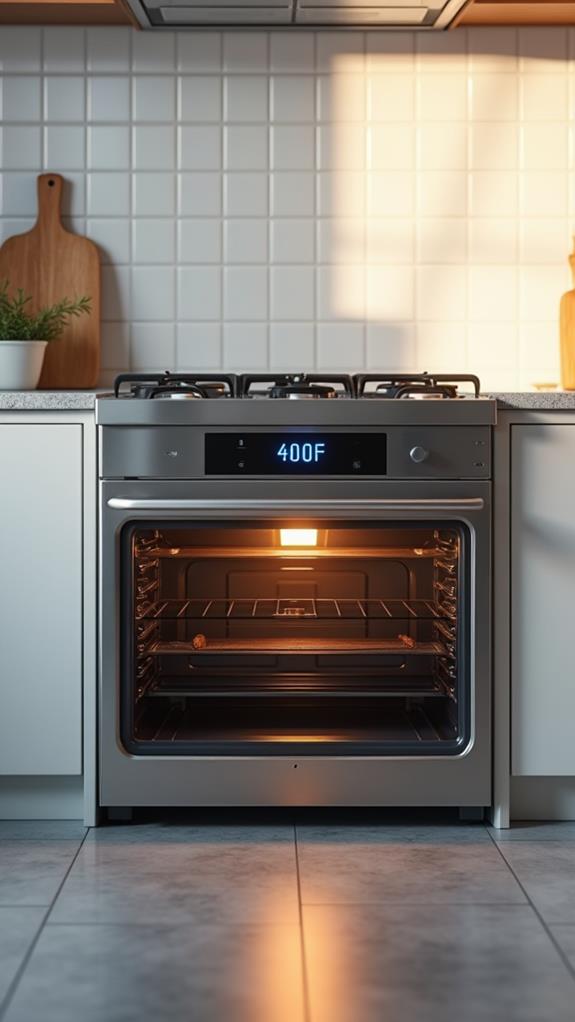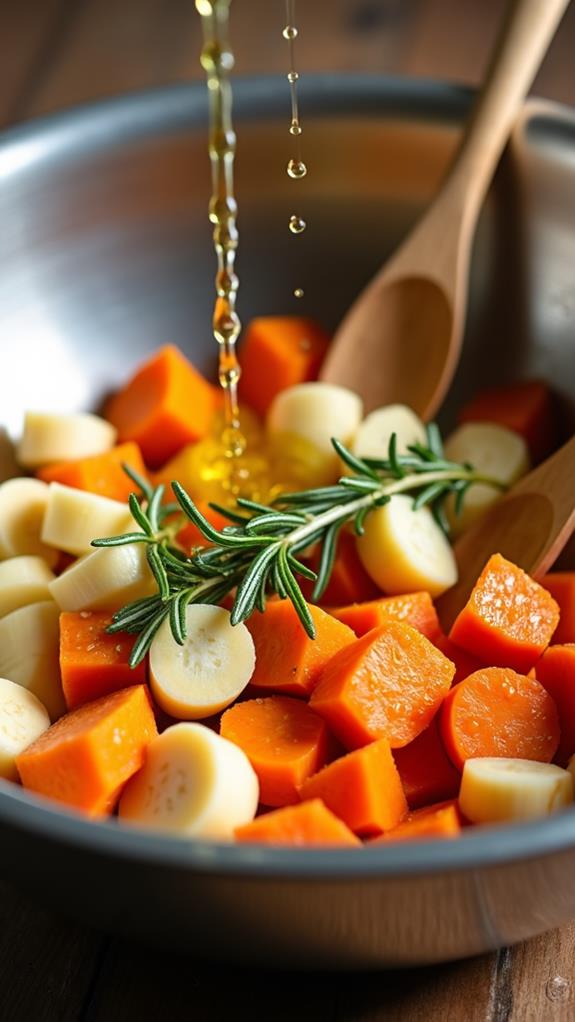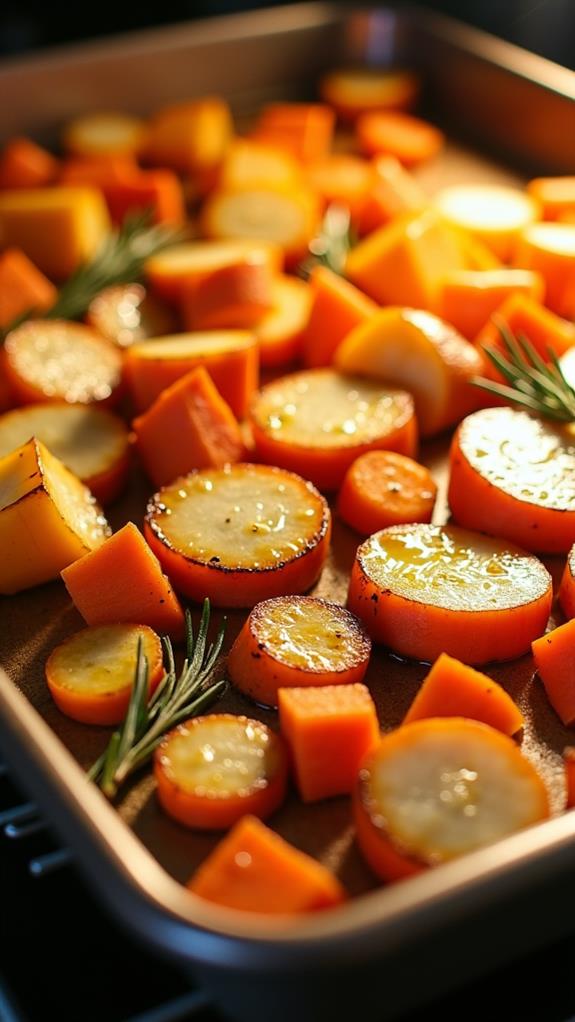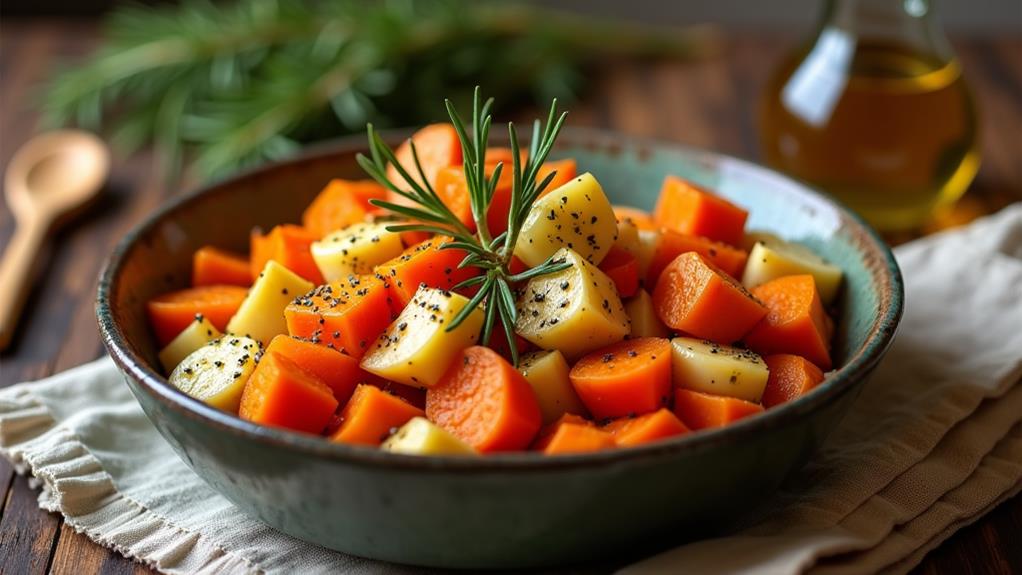You've likely encountered roasted root vegetables before, but have you truly explored the depth of flavors this simple dish can offer? From the humble carrot to the oft-overlooked parsnip, root vegetables transform into caramelized delights when roasted. This medley isn't just a side dish; it's a celebration of autumn's bounty and a testament to the power of heat and seasoning. As you consider incorporating this versatile dish into your meal planning, you'll find there's more to discover about its history, variations, and the science behind that perfect roast. Let's unearth the secrets of this comforting classic.
Key Takeaways
- Roasted root vegetable medley combines carrots, parsnips, and sweet potatoes for a hearty, nutritious side dish.
- Toss vegetables with olive oil and rosemary, then roast at 400°F (200°C) for 35-40 minutes.
- Ensure vegetables are spread in a single layer on the baking sheet for even roasting and caramelization.
- Experiment with additional root vegetables, herbs, and toppings for variety and added flavor.
- Leftovers can be stored for up to 3 days and easily reheated, making it ideal for meal prep.
History
For centuries, root vegetables have been a staple in cuisines around the world. You'll find that these hearty, underground-growing plants have sustained populations through harsh winters and lean times. They've been prized for their long shelf life and ability to provide essential nutrients when other food sources were scarce.
The practice of roasting root vegetables dates back to ancient civilizations. You'd have seen early humans using hot stones or primitive ovens to cook these tough, fibrous plants, making them more palatable and easier to digest.
As cooking techniques advanced, so did the ways people prepared root vegetables. In medieval Europe, you'd have found them roasted in large fireplaces, often alongside meats to absorb the savory juices.
Today's roasted root vegetable medley is a modern twist on this age-old cooking method. You're now able to combine various root vegetables, like carrots, parsnips, and sweet potatoes, in a single dish.
This approach allows you to enjoy a diverse array of flavors and textures, while still honoring the traditional cooking techniques of our ancestors.
Recipe
Roasted root vegetables are a comforting and versatile side dish that can complement a wide range of main courses. This simple yet delicious medley combines the earthy flavors of carrots, parsnips, and sweet potatoes, enhanced by the aromatic notes of rosemary and the richness of olive oil.
Perfect for autumn and winter meals, this roasted root vegetable medley isn't only easy to prepare but also packed with nutrients. The natural sweetness of the vegetables intensifies during the roasting process, creating a dish that's both wholesome and satisfying.
- 2 medium carrots (about 1 cup or 150g), peeled and cut into 1-inch pieces
- 2 medium parsnips (about 1 cup or 150g), peeled and cut into 1-inch pieces
- 1 large sweet potato (about 2 cups or 300g), peeled and cut into 1-inch cubes
- 2 tablespoons (30ml) olive oil
- 1 tablespoon fresh rosemary, chopped
Preheat the oven to 400°F (200°C). In a large bowl, toss the carrots, parsnips, and sweet potato with olive oil and chopped rosemary until evenly coated.
Spread the vegetables in a single layer on a baking sheet, ensuring they're not overcrowded. Roast for 35-40 minutes, stirring halfway through, until the vegetables are tender and lightly caramelized around the edges. Remove from the oven and serve hot.
For best results, cut the vegetables into uniform sizes to ensure even cooking. If you prefer a more caramelized exterior, you can increase the oven temperature to 425°F (220°C) for the last 5-10 minutes of cooking.
Feel free to experiment with different root vegetables or herbs to suit your taste preferences. Leftovers can be stored in an airtight container in the refrigerator for up to 3 days and reheated in the oven or microwave.
Cooking Steps
To create this comforting roasted root vegetable medley, you'll start by preheating your oven to 400°F (200°C).
Next, you'll toss your carefully prepared vegetables with olive oil and rosemary in a large bowl, ensuring they're evenly coated.
Step 1. Preheat Oven to 400°F

Before you begin preparing the vegetables, it's crucial to preheat your oven to 400°F (200°C). This step ensures that your oven reaches the optimal temperature for roasting root vegetables, allowing them to cook evenly and develop a delicious caramelized exterior.
While your oven heats up, you'll have time to wash, peel, and chop your vegetables.
To preheat your oven, simply turn it on and set the temperature dial or digital display to 400°F (200°C). Most modern ovens will indicate when they've reached the desired temperature, often with a light or sound. If your oven doesn't have this feature, allow about 15-20 minutes for it to fully preheat.
It's important not to rush this step, as placing your vegetables in a cold oven can result in uneven cooking and a less appetizing final dish.
While waiting, you can prepare your baking sheet by lining it with parchment paper or lightly greasing it with oil to prevent sticking.
Step 2. Toss Vegetables With Oil

Once your vegetables are washed, peeled, and chopped, it's time for the flavor-enhancing step of tossing them with oil. In a large mixing bowl, combine your carrot, parsnip, and sweet potato pieces. Drizzle the olive oil evenly over the vegetables, ensuring each piece gets a light coating. This oil serves two purposes: it helps the vegetables roast evenly and creates a crispy exterior while maintaining a tender interior.
Add the chopped rosemary to the bowl, distributing it throughout the mixture. Using your hands or a large spoon, gently toss the vegetables until they're evenly coated with oil and herbs.
Be thorough but gentle to avoid breaking or mashing the softer pieces. As you mix, you'll notice the vibrant colors of the vegetables becoming more pronounced, a sign that they're ready for roasting. This step not only seasons the vegetables but also helps the rosemary's aromatic oils release, infusing the dish with its distinctive flavor.
Once everything is well-coated, you're ready to spread the vegetables on your baking sheet for the next step in creating your delicious roasted root vegetable medley.
Step 3. Spread Vegetables on Baking Sheet

After tossing your vegetables with oil and herbs, it's time to prepare them for roasting. Grab a large baking sheet and line it with parchment paper or aluminum foil for easy cleanup. This step isn't necessary, but it'll save you time later.
Now, carefully transfer your seasoned vegetables onto the baking sheet. It's crucial to spread them out in a single layer, ensuring they're not overcrowded. If the vegetables are too close together, they'll steam instead of roast, resulting in a less desirable texture.
You want each piece to have direct contact with the hot surface of the pan to achieve that perfect caramelization. If you find that your baking sheet is too small to accommodate all the vegetables without overcrowding, don't hesitate to use two sheets.
It's better to divide them between two pans than to pile them up on one. Remember, proper spacing is key to achieving those crispy edges and tender centers that make roasted vegetables so irresistible.
Once you've arranged your vegetables, they're ready for the oven.
Step 4. Roast for 35-40 Minutes

The oven's heat transforms your vegetable medley into a delicious side dish. Once you've spread the vegetables evenly on your baking sheet, it's time to let the roasting process work its magic. Set your timer for 35 minutes, allowing the vegetables to cook undisturbed for the first half of the roasting time.
After about 20 minutes, you'll want to give your vegetables a stir. This ensures even cooking and prevents any pieces from sticking to the baking sheet. Use a spatula or wooden spoon to gently turn the vegetables, redistributing them across the sheet.
Return the baking sheet to the oven for the remaining 15-20 minutes. Keep a close eye on your vegetables during the final minutes of roasting. They're done when they're fork-tender and lightly caramelized around the edges.
If you prefer a more intense caramelization, you can increase the oven temperature to 425°F for the last 5-10 minutes. Once roasted to perfection, remove the baking sheet from the oven. Your root vegetable medley is now ready to serve and enjoy.
Step 5. Serve Immediately With Garnish

Fresh from the oven, your roasted root vegetable medley is ready to shine. Carefully remove the baking sheet, using oven mitts to protect your hands from the heat.
You'll notice the vegetables have taken on a beautiful golden-brown color, with slightly crispy edges that indicate perfect caramelization.
Transfer the roasted vegetables to a serving dish, arranging them attractively to showcase their vibrant colors. For an extra touch of flavor and visual appeal, sprinkle some fresh herbs over the top. Chopped parsley or thyme work well, complementing the rosemary you've already used.
If you'd like to add a bit of crunch, consider topping the dish with a handful of toasted pine nuts or pumpkin seeds.
Serve your roasted root vegetable medley immediately while it's still hot and at its peak flavor. The warmth of the dish will release enticing aromas, making it even more inviting.
Don't forget to provide serving utensils, allowing your guests to help themselves to generous portions of this delicious and nutritious side dish.
Final Thoughts
Roasted root vegetables bring out the best in fall and winter produce. They're a versatile side dish that you can easily adapt to your preferences.
Don't hesitate to experiment with different combinations of root vegetables, herbs, and seasonings. You'll find that this cooking method enhances the natural sweetness and flavors of the vegetables, creating a satisfying and nutritious addition to your meals.
Remember, the key to perfectly roasted vegetables lies in uniform cutting and proper spacing on the baking sheet. This ensures even cooking and allows for that desirable caramelization.
If you're short on time, you can prepare the vegetables in advance and store them in the refrigerator until you're ready to roast. This dish is also an excellent option for meal prep, as it reheats well and can be enjoyed throughout the week.















